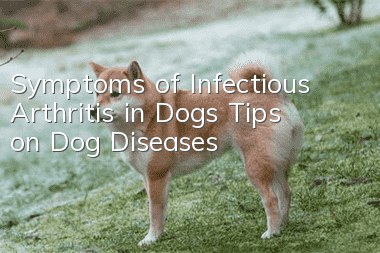Symptoms of Infectious Arthritis in Dogs Tips on Dog Diseases

Symptoms of infectious arthritis in dogs
X-ray examination
1. Early X-rays show thickening of the joint synovium and joint capsule and widening of the joint cavity. As the condition worsens, joint damage occurs, the tissue around the joint is sparse, the joint surface is irregular, and some show fibrous or bony ankylosis.2. Joint puncture revealed degeneration of synovial fluid and an increase in leukocytes, mostly neutrophils.
3. Puncture bacterial culture can be done to determine the type of bacterial infection. However, it is difficult to detect the results of bacterial culture in patients who have been treated with antibiotics.
Clinical symptoms
1. The affected joints are swollen, hot and painful, a large amount of serous, fibrous or purulent exudate accumulates in the joint cavity, the joint capsule swells, and there is a fluctuating sensation when pressed.2. Claudication of the affected limb is often accompanied by an increase in body temperature; over time, the articular cartilage is destroyed, the subchondral bone is eroded, bone hyperplasia around the joint bone, and the synovial membrane is thickened; in the later stage, it may develop into fibrous or osseous Sexual joint healing, ankylosis or dead joints.
Causes of infectious arthritis in dogs
1. Exogenous joint infection is common after joint trauma, direct infection by pathogenic bacteria or the spread of purulent inflammation in the same tissue around the joint.2. Blood-borne infection, which refers to the infection of joints by pathogenic bacteria from primary lesions such as pneumonia, umbilical corditis, and urinary tract infection.
3. Iatrogenic infections are common in surgical contamination such as arthrotomy and joint puncture.
Prevention and treatment measures for dog infectious arthritis
1. Based on bacterial culture and drug sensitivity testing, antibiotics that are sensitive to bacteria can be used for several weeks until the infection subsides. It can be administered intravenously within the first 48 hours to quickly control the infection.2. Move the joints appropriately to prevent joint adhesions in sick dogs, but it is not advisable to bear weight within 3 to 4 months to avoid wear and tear of articular cartilage.
3. When too much pus accumulates in the joint, puncture or incision can be made, and a drainage tube can be placed to facilitate the discharge of purulent secretions and flushing. Rinse with sterile isotonic solution once a day.
4. In patients with a long course of disease, the articular cartilage and articular bone are generally more severely damaged. After the inflammation is controlled, it is easy to turn into degenerative joint disease, and the function is difficult to recover.
Random articles
- How many months does it take for a dog to recognize its owner?
- Schnauzer fixed point toilet training method
- How long does a dog’s period usually take? What should you pay attention to during your dog’s period?
- How high is a Schnauzer's IQ? How old is a Schnauzer's IQ equivalent to a child?
- 20 kinds of food and fruits that dogs cannot eat
- Can dogs take the train home? It's okay for small dogs, but it's not recommended for owners who travel long distances
- What are the signs of a dog being spoiled? These are the signs a dog is spoiled!
- Six major reasons and suggestions for dog hair loss
- What will happen to a dog if he eats salty food?
- How many hours of sleep is better for a Husky every day?



